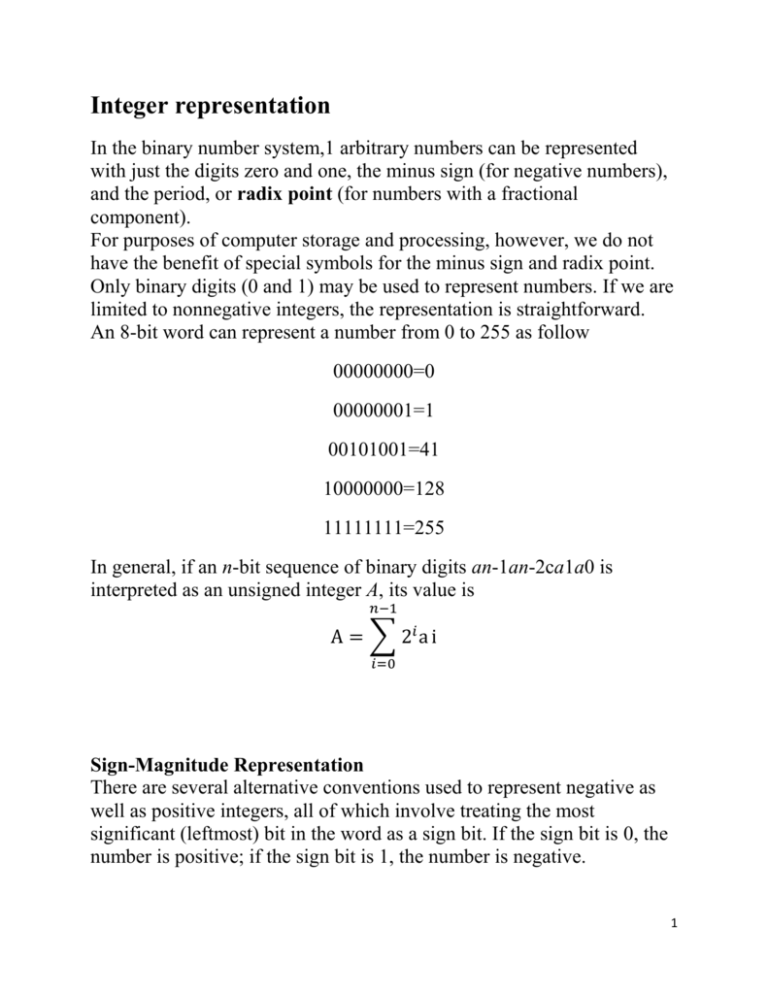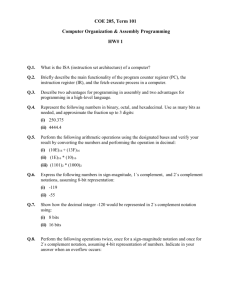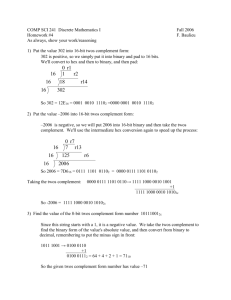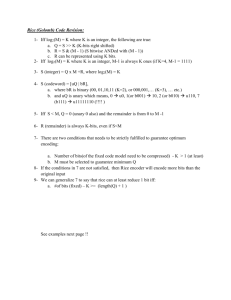Hajer_Ahmed_Integer_representation
advertisement

Integer representation In the binary number system,1 arbitrary numbers can be represented with just the digits zero and one, the minus sign (for negative numbers), and the period, or radix point (for numbers with a fractional component). For purposes of computer storage and processing, however, we do not have the benefit of special symbols for the minus sign and radix point. Only binary digits (0 and 1) may be used to represent numbers. If we are limited to nonnegative integers, the representation is straightforward. An 8-bit word can represent a number from 0 to 255 as follow 00000000=0 00000001=1 00101001=41 10000000=128 11111111=255 In general, if an n-bit sequence of binary digits an-1an-2ca1a0 is interpreted as an unsigned integer A, its value is 𝑛−1 A = ∑ 2𝑖 a i 𝑖=0 Sign-Magnitude Representation There are several alternative conventions used to represent negative as well as positive integers, all of which involve treating the most significant (leftmost) bit in the word as a sign bit. If the sign bit is 0, the number is positive; if the sign bit is 1, the number is negative. 1 The simplest form of representation that employs a sign bit is the sign magnitude representation. In an n-bit word, the rightmost n - 1 bits hold the magnitude of the integer. +18 = 00010010 -18 = 10010010 There are several drawbacks to sign-magnitude representation. One is that addition and subtraction require a consideration of both the signs of the numbers and their relative magnitudes to carry out the required operation. Another drawback is that there are two representations of 0: +010=00000000 -0 10=10000000 This is inconvenient because it is slightly more difficult to test for 0 (an operation performed frequently on computers) than if there were a single representation. Because of these drawbacks, sign-magnitude representation is rarely used in implementing the integer portion of the ALU. Instead, the most common scheme is twos complement representation. Twos Complement Representation Like sign magnitude, twos complement representation uses the most significant bit as a sign bit, making it easy to test whether an integer is positive or negative. It differs from the use of the sign-magnitude representation in the way that the other bits are interpreted. Most treatments of twos complement representation focus on the rules for producing negative numbers, with no formal proof that the scheme is valid. twos complement representation is best understood by defining it in terms of a weighted sum of bits, as we did previously for unsigned and sign-magnitude representations. The advantage of this treatment is that it does not leave any lingering doubt that the rules for arithmetic operations in twos complement notation may not work for some special cases. 2 Consider an n-bit integer, A, in twos complement representation. If A is positive, then the sign bit, an-1, is zero. The remaining bits represent the magnitude of the number in the same fashion as for sign magnitude: 𝑛−2 A = ∑𝑖=0 2𝑖 𝑎𝑖 for A>=0 The number zero is identified as positive and therefore has a 0 sign bit and a magnitude of all 0s. We can see that the range of positive integers that may be represented is from 0 (all of the magnitude bits are 0) through 2n-1 - 1 (all of the magnitude bits are 1). Any larger number would require more bits. 3 4 5










